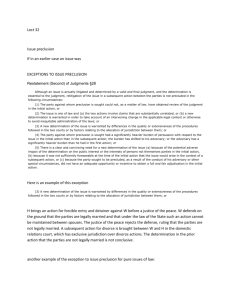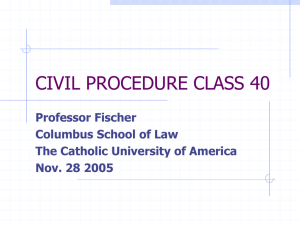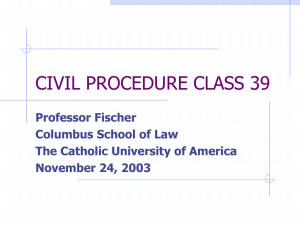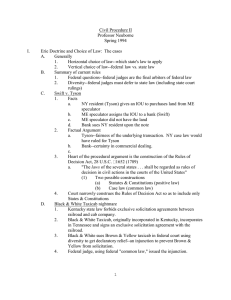Lect 24 What we have done so far P files an action against D in
advertisement
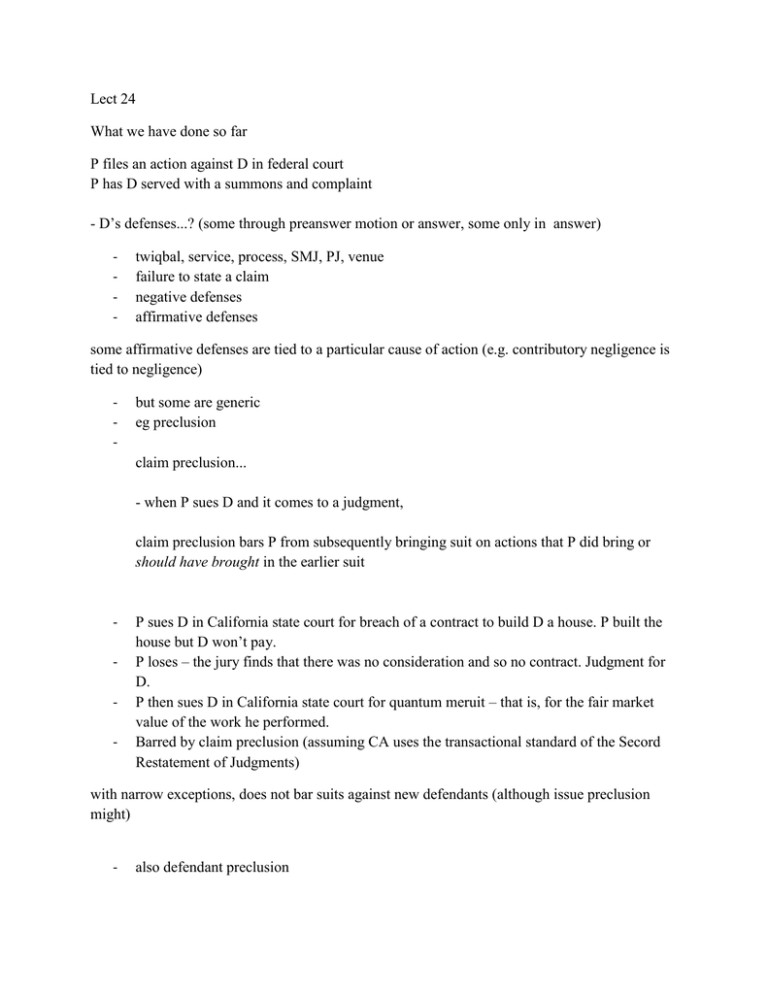
Lect 24 What we have done so far P files an action against D in federal court P has D served with a summons and complaint - D’s defenses...? (some through preanswer motion or answer, some only in answer) - twiqbal, service, process, SMJ, PJ, venue failure to state a claim negative defenses affirmative defenses some affirmative defenses are tied to a particular cause of action (e.g. contributory negligence is tied to negligence) - but some are generic eg preclusion claim preclusion... - when P sues D and it comes to a judgment, claim preclusion bars P from subsequently bringing suit on actions that P did bring or should have brought in the earlier suit - P sues D in California state court for breach of a contract to build D a house. P built the house but D won’t pay. P loses – the jury finds that there was no consideration and so no contract. Judgment for D. P then sues D in California state court for quantum meruit – that is, for the fair market value of the work he performed. Barred by claim preclusion (assuming CA uses the transactional standard of the Secord Restatement of Judgments) with narrow exceptions, does not bar suits against new defendants (although issue preclusion might) - also defendant preclusion o P sues D in California state court for negligence in connection with a car accident. P wins – the jury finds that D was negligent and awards P $100,000. $100,000 in D’s bank account is attached by the court and given to P. D sues P in California state court to get the $100,000 wrongfully taken from him, offering a defense that was not o Barred by defendant preclusion o distinguish defendant preclusion from compulsory counterclaim rule o o o o P sues D for negligence in a car accident P gets a judgment of $100,000, which is executed D then sues P for his damages in the car accident This is not a case for defendant preclusion, but if the relevant jurisdiction has a compulsory counterclaim rule, D’s action is barred distinguish claim preclusion from issue preclusion’ - - P sues D for breaching a contract requiring D to give P coal every winter - In the suit D challenges the validity of the contract - The court determines the contract to be valid P wins damages from D - The next winter, D breaches again - P once again sues D for breach - Is P claim precluded? NO – new transaction - D once again challenges the validity of the contract - Anything P can do? Use issue preclusion if a party fully and fairly litigated an issue in an earlier case he can (with certain exceptions) be barred from relitigating the same issue in subsequent proceedings requirements for claim preclusion there must be: a final judgment - 1st case must have reached a judgment But it can still be on appeal the judgment must be: valid BUT unless the defendant defaulted, generally the defendant cannot challenge the validity of the first judgment – e.g. P sues D in federal court in NY. D appears. There is no PJ over D but no one notices this fact. Judgment for P. P then brings a separate suit in state court in Cal. to enforce the judgment. Can D challenge the earlier judgment on the grounds that there was no PJ? NO – PJ was waived P sues D in federal court in NY. D appears. There is no SMJ, but no one notices this fact. P then brings a separate suit in state court in Cal. to enforce the judgment. Can D challenge the earlier judgment on the grounds that there was no SMJ? NO (used to be yes) P sues D in federal court in connection with an accident. There is no SMJ. D defaults. P then tries to sue D on the judgment in state court. Can D challenge the judgment as invalid? YES – the judgment must be on the merits - will get to this eg –a dismissal for lack of PJ is not on the merits - dismissal for failure to state a claim? - - P sues D for intentional infliction of emotional distress - D gets the action dismissed for failure to state a claim (P did not allege requisite intent) - P then sues D for negligent infliction of emotional distress concerning the same transaction - The federal approach is that a dismissal for failure to state a claim is presumptively on the merits – it is on the merits unless the court dismissing says it is without prejudice So: If a final valid judgment on the merits then… If judgment is for P, P’s claim is merged in the judgment (no new causes of action about the transaction allowed) If judgment is for D, P’s claim is extinguished (no new causes of action about the transaction allowed) What is the scope of a claim? How far does claim preclusion extend? Williamson v. Columbia Gas & Electric 3d Cir 1950 Start with this suit (action 1) - suit brought in D. Del. by Williamson against Columbia claiming that it conspired with other persons in violation of Sherman Act to drive him out of business - Columbia was only defendant While the first was ongoing a second suit was brought in D. Del. by Williamson against Columbia claiming that it acted as a sole actor to drive him out of business in violation of the Clayton Act - Clayton Act action was dismissed - due to stipulation that cause of action accrued no later than Jan 1, 1931 - P thought that Del. statute of limitations would save him – but it didn’t (note – when federal statutes lack a statute of limitations, federal courts will borrow an analogous limitations period from the forum state’s law) - D moved for summary judgment on Sherman Act action, due to claim preclusion - motion granted - P appealed - Ct App affirms - the precluding suit was brought after the precluded suit (even though it came to a decision earlier) - doesn’t that matter? - NO - WHY NOT? - the idea is that claim preclusion is a punishment for duplicative litigation and that is what the plaintiff engaged in Assume that the stipulation about the accrual of the cause of action had been accepted in the Sherman Act suit, would that suit have been barred by the statute of limitations? - NO - the D is engaging in continuing wrongdoing (the conspiracy is still going on) so it is likely that the Sherman Act action would not be barred - given this fact, why should the Sherman Act action not be able to continue? The question is not whether the Sherman Act action has merit – the action is barred by claim preclusion despite its merits in general you are expected to bring all possible causes of actions concerning the same transaction in the same suit - It is often the case that the suit barred had merit Can Williamson bring the Clayton Act suit in federal court in another jurisdiction? - YES - many jurisdictions take the dismissal of actions for statute of limitations to not bar a plaintiff from suing again in another jurisdiction that has a longer limitations period - the dismissal is claim precluded only in the jurisdiction itself - that was true for federal antitrust actions in federal court Here is another example: - P sues D in Pa. state court under NY negligence law for his property damages in a NY accident. - P’s action is dismissed by due to Pa.’s 1 year statute of limitations for negligence. - May P sues D in Pa. state court for his personal damages concerning the same accident? NO - May P sues D in Del. state court for his property damages concerning the same accident? (Del. has a 2 year statute of limitations for negligence.) YES Can Williamson bring the Sherman Act suit in federal court in another jurisdiction? - argument that he can’t? – the dismissal of the Sherman Act action was not on statute of limitations grounds – it was on claim preclusion grounds - but the answer is probably that he can - if the dismissal of the Sherman Act action had claim preclusive effect in all jurisdictions, then all actions concerning the same transaction would also be barred in all jurisdictions, including the Clayton Act action – but we know that is not true The question remains whether the Sherman and Clayton Act actions concern the same transaction and so are part of the same claim - doesn’t matter that different statutes (Sherman act and Clayton act) are used? - No - “causes of action” can be different Does it matter that conspiracy is alleged in one and not in the other? - different evidence? - some, but the overlap of evidence does not have to be perfect for two actions to be part of the same “claim” - transactional test used by the court... - both cases involved a claim that the D gained control of his company and drove it into bankruptcy in order to stifle competition – the same transaction is basically at issue - also note that because the plaintiff loses actions that he does not bring if they are part of the same claim, the dimensions of a claim need to be easily recognizable – it cannot depend upon very fact-intensive questions of the exact extent of evidentiary overlap § 24. Dimensions Of “Claim” For Purposes Of Merger Or Bar—General Rule Concerning “Splitting” (1) When a valid and final judgment rendered in an action extinguishes the plaintiff's claim pursuant to the rules of merger or bar the claim extinguished includes all rights of the plaintiff to remedies against the defendant with respect to all or any part of the transaction, or series of connected transactions, out of which the action arose. (2) What factual grouping constitutes a “transaction”, and what groupings constitute a “series”, are to be determined pragmatically, giving weight to such considerations as whether the facts are related in time, space, origin, or motivation, whether they form a convenient trial unit, and whether their treatment as a unit conforms to the parties' expectations or business understanding or usage. NOTE: There is a defense of claim splitting if a P splits a claim the D can get the later filed actions dismissed without prejudice why didn’t Columbia Gas use this defense?- it wanted to wait for an action to come to judgment so it could use claim preclusion! - since the D acquiesced in claim splitting, is that a reason to deny the D the benefit of claim preclusion? The modern view is yes So when is claim preclusion available? P sues D concerning a transaction. It comes to a judgment. P then sues D concerning the same action. Claim precluded. P sues D concerning an action. While the first action is going, P sues D concerning the same transaction. One of them comes to judgment, without D having brought up claim splitting. Modern view: P is not claim precluded concerning the remaining action because the defendant acquiesced in claim splitting. interjurisdictional claim preclusion - P sues D in state court in Georgia for breach of contract - Georgia preclusion law allows separate suits in law and equity - Judgment for D, there was no contract - P then sues D in state court in California for quantum meruit - California preclusion law does not allow separate suits in law and equity which law to use? Georgia’s this follows from Full Faith and Credit Clause – to give a judgment full faith and credit is to give the judgment the same preclusive effect it would have in the rendering state’s courts CLAIM SPLITTING Sutcliffe Storage & Warehouse Co. v. U.S. (4th Cir. 1947) four actions brought in dist ct in MA for compensation for use of land by Navy that was not within lease Why divided up this way? - to keep under jurisdictional limit of the Tucker Act - if more than $10K would go to Ct Claims in DC - Dist Ct dismissed w/o prejudice subsequent actions as claim-splitting - under claim splitting a court dismisses all but first claims w/o prejudice if the actions are on the same claim - what is difference from claim preclusion? - no final judgment and dismissal is without prejudice Ct App aff’d But aren’t each of these claims different transactions because they concern different renewal periods for the lease? - but use was claimed to be outside of the leases - and, in any event, if the defendant engages in a continuing course of conduct the entirety of damages from the conduct up to the time of filing must be sued for or claim preclusion will apply
